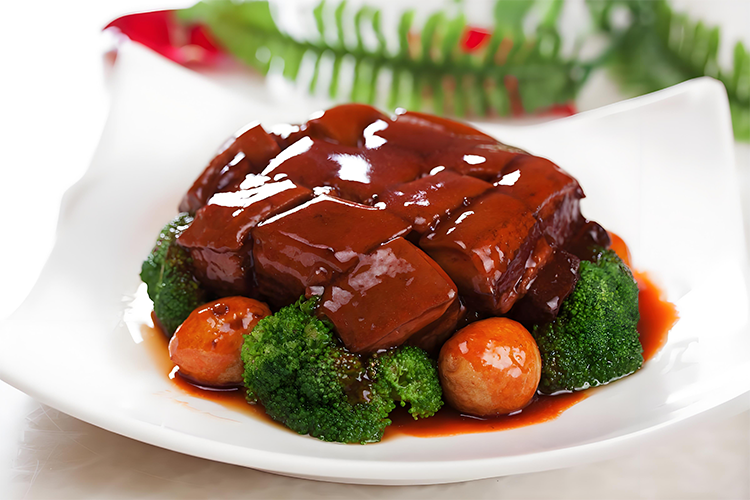Dongpo Pork: A Hangzhou Classic
1. Taste Jiangnan: One Bite of Dongpo Pork Captures Hangzhou’s Elegance
Imagine a neat square of pork, glistening like amber, placed before you. A gentle pinch with chopsticks and the skin yields, the fat and lean layers melting on your tongue. This is not ordinary braised pork—this is Dongpo Pork, a nearly thousand-year-old Jiangnan (southern Yangtze) specialty tied to the Song-dynasty literati Su Dongpo. In Hangzhou, missing this “scholar’s dish” is leaving a blank on your China food map.
2. Origin and History: A Famous Dish Born from a Happy Mistake
Dongpo Pork’s legend follows its namesake, the Northern Song poet-official Su Dongpo (Su Shi). In 1071 he served as prefect in Hangzhou and improved the West Lake embankments (the famous Su Causeway). Grateful locals, who knew of his fondness for pork and his poem praising it, carried pigs and wine to thank him.
Unable to refuse, Su instructed his household to cut pork into squares and braise it until glossy, returning portions with wine to the workers. A family member misheard “return with wine” as “braise with wine,” so they cooked the pork submerged in Shaoxing wine together with soy and sugar. The result—a tender, richly flavored braised pork—was an unexpected triumph. Workers called it “Dongpo Pork” in his honor. Over centuries it moved from folk kitchens to teahouse menus and became a crown jewel of Zhejiang cuisine.

3. Cultural Meaning: Slow Simmering, Scholar’s Temperament
Dongpo Pork transcends mere taste; it embodies a cultural mindset. Su Dongpo’s cooking philosophy—”simmer gently, use little water, and when heat is right the dish will be perfect”—mirrors a life attitude of patience and graceful resilience. In one hearty square of meat you taste a scholar’s joy in everyday comforts.
Eating Dongpo Pork is tasting a refined, literati lifestyle: deliberate, elegant, and quietly joyous. It’s a signature of Hangzhou’s food culture and a shining example of Jiangnan cuisine’s focus on balance and subtlety.
4. Ingredients and Technique: Simple Elements, Meticulous Craft
Authentic Dongpo Pork relies on few, quality ingredients: premium pork belly, Shaoxing wine, soy sauce, rock sugar, and scallion and ginger to lift the aroma. No heavy spices—just pure focus on texture and wine-scent.
Key steps:
- Selection: Choose pork belly with alternating lean and fat layers (traditional Jinhua “two-black” pig is prized).
- Cutting and tying: Cut 4cm squares and tie with kitchen twine to keep shape during long braise.
- Blanching: Start in cold water and bring to a boil to remove scum and impurities.
- Braising: Place the pieces skin-side down in a clay pot, layer with scallion and ginger, pour sufficient Shaoxing wine (used instead of plain water), add light and dark soy, and rock sugar. Bring to a boil, then reduce to the lowest heat and simmer for at least two hours.
- Glazing: Turn the meat periodically so it soaks evenly. Finish by reducing the sauce until glossy and thick.
No extra water is added—Shaoxing wine both flavors and helps tenderize the meat. The result: meat so soft it holds together but falls apart on the fork, richly infused with wine aroma.

5. Flavor and Serving: A Symphony on the Palate
A successful Dongpo Pork is a feast for the eyes and the palate.
- Appearance: Deep, lacquered red like fine carnelian, with sauce clinging to each surface.
- Taste and texture: First comes the silky, slightly sweet skin full of collagen; then the velvety fat—rich but not greasy—and finally the fluffy, fragrant lean meat. Shaoxing wine leaves a warm, rounded aroma that cuts through richness and accentuates layers of salty, sweet, and savory.
- How to eat: The classic way is to place a chunk atop steaming white rice and spoon glossy sauce over it. Break the meat slightly with a spoon and mix—each rice grain should be coated. One bite of meat, one bite of rice: pure comfort.
6. Where to Taste and Travel Tips: Eat Like a Local
- Best places: Head to Hangzhou. Renowned restaurants such as Lou Wai Lou (by West Lake, combining view and history), Hangzhou Restaurant, and Shan Wai Shan are famous for their Dongpo Pork.
- Ordering tips: Dongpo Pork is often sold per portion—one chunk per person—making it a showpiece of any banquet. Share it with friends and balance the meal with lighter Hangzhou classics like Longjing shrimp and West Lake vinegar fish.
- Pairings: A cup of aromatic Shaoxing wine complements the dish perfectly; Longjing green tea is an excellent palate cleanser.
- Travel plan: Combine a West Lake morning stroll (Su Causeway, where Su Dongpo’s influence lingers) with a midday Dongpo Pork lunch at a traditional restaurant for a cultural and culinary half-day.

7. Simple Home Version: Recreate Jiangnan Comfort at Home
You can try a simplified Dongpo Pork at home with accessible steps:
- Ingredients: pork belly, scallions, ginger, Shaoxing wine (essential), light and dark soy sauce, rock sugar.
- Method: Blanch the pork, sear lightly, then add scallion and ginger. Pour enough Shaoxing wine (you can mix a little water if needed), add soy and sugar.
- Simmer: Bring to a boil, then cover and simmer on low for 1.5–2 hours. Monitor liquid so it doesn’t run dry.
- Reduce: Uncover and increase heat to thicken the sauce until shiny and clingy.
This home version won’t perfectly match a restaurant’s depth, but it captures the soul of Dongpo Pork.

8. Conclusion
Dongpo Pork is more than a dish: it’s a story, a cultural fragment, and a taste of Hangzhou’s genteel spirit. From simple pork and Shaoxing wine, centuries of technique and scholarly taste created an enduring classic. When you visit Zhejiang, leave room in your itinerary—and your appetite—for a square of Dongpo Pork and a bowl of steamed rice. It will tell you, in the best possible way, a little of Su Dongpo’s generosity and Jiangnan’s refined flavors.


